
How do you maintain and clean a patio umbrella?
To keep your outdoor umbrella looking good and working well each year, you should clean, maintain, and protect it.

Shade umbrella maintenance tips
Throughout the warm seasons, a bit of common sense and care can help keep your outdoor umbrella in great shape. This will delay the need to replace your umbrella’s canopy, ribs, or frame.
Open it gently
Most umbrellas are designed to rest comfortably in a fully closed position. To open yours safely, push the main canopy ribs away from the pole a little. Then, engage the lift mechanism. If you see the umbrella having trouble opening, don’t force it. You might need to remove twigs or leaves that are blocking it.
Close it when not in use
Even if you have a strong base or mount, it’s smart to keep your sun umbrella closed and locked when not in use. Inclement weather and high winds can play havoc with an open umbrella. Rather than risk damaging your umbrella’s ribs or launching it across the yard, take a few moments to close the canopy. Many manufacturers exclude wind damage from their warranties, so be smart.
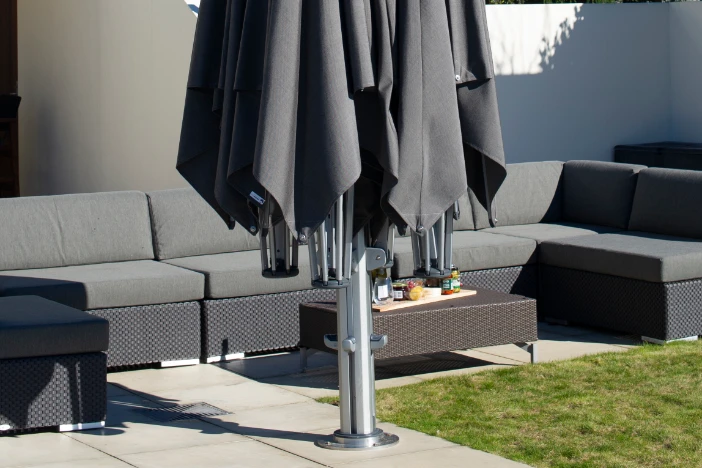
Keep it dry
Ideally, you should employ an umbrella cover whenever it’s not in use. In addition to protecting it from unnecessary exposure to the sun, a cover helps keep out mildew-causing moisture. If you can’t always put it on, be sure that you completely dry the canopy before closing the umbrella. Most outdoor canopy fabrics are treated to resist mold and mildew. However, moisture can still collect in the folds of a closed umbrella.
Preserve UV resistance & water repellency
Even good outdoor fabrics, like solution-dyed acrylics (for example, Sunbrella), will gradually lose their UV protection. They will also lose their water resistance over time. To extend their performance, consider applying fabric treatments annually—especially in harsh climates or with heavy use. Products like 303 Fabric Guard can help restore waterproofing, while UV-protection sprays offer additional shielding against sun degradation. Top-quality materials are naturally UV-resistant. However, applying protectants from time to time helps keep the fabric looking good and lasting longer.
Prevent corrosion on frames & hardware
In coastal or humid environments, corrosion can be a major issue for metal components. Regularly inspect umbrella frames—especially at joints, screws, and moving parts—for any signs of rust or wear. Apply a dry silicone spray or a corrosion inhibitor to protect exposed hardware. If your umbrella includes dissimilar metals (like aluminum and stainless steel), take extra care to avoid galvanic corrosion. For minor paint scratches or finish chips on metal frames, touch them up using manufacturer-recommended products. Wood frames may require periodic re-sealing or staining to resist moisture and UV damage.

Lubricate tilt, crank & rotation mechanisms
Frequent use of umbrellas with cranks, tilt mechanisms, or rotating bases can lead to wear on internal parts. To keep these parts working well, use a dry silicone lubricant (not WD-40, as it attracts dust) at least once a season. Focus on key moving joints and test for any stiffness. If your umbrella includes wooden joints or specialty parts, use appropriate lubricants as recommended. Proper lubrication not only ensures smooth operation but also helps prevent mechanical failure over time.
Inspect for damage & make repairs
Outdoor umbrellas face a lot of stress from wind, sun, and use. It’s important to check them regularly for damage. Look for bent ribs, cracked struts, torn fabric, or snapped crank cords. Many brands offer replacement parts or repair kits that allow for straightforward fixes. For higher-end models, you might also consider contacting a professional upholstery or canvas repair service. Additionally, check and tighten all screws, bolts, and fasteners regularly, as these can loosen with vibration and weather exposure.
Deter insects & nesting pests
Folded umbrellas can attract pests like spiders, ants, or wasps. This is especially true if they are left closed for a long time. To avoid infestations, check your umbrella before using it. Clean it often with non-sugary products that won’t attract insects. A light spray of citrus or other gentle natural repellents can help keep birds from nesting in canopies or hollow poles. Staying vigilant helps maintain not only cleanliness but also safety during use.
Review manufacturer recommendations
Each manufacturer has instructions and tips for using their umbrellas. Some woods require periodic oiling, while others can go without it completely. Different materials and designs have specific care guidelines. Make sure to learn what you need to do before setting up your umbrella.
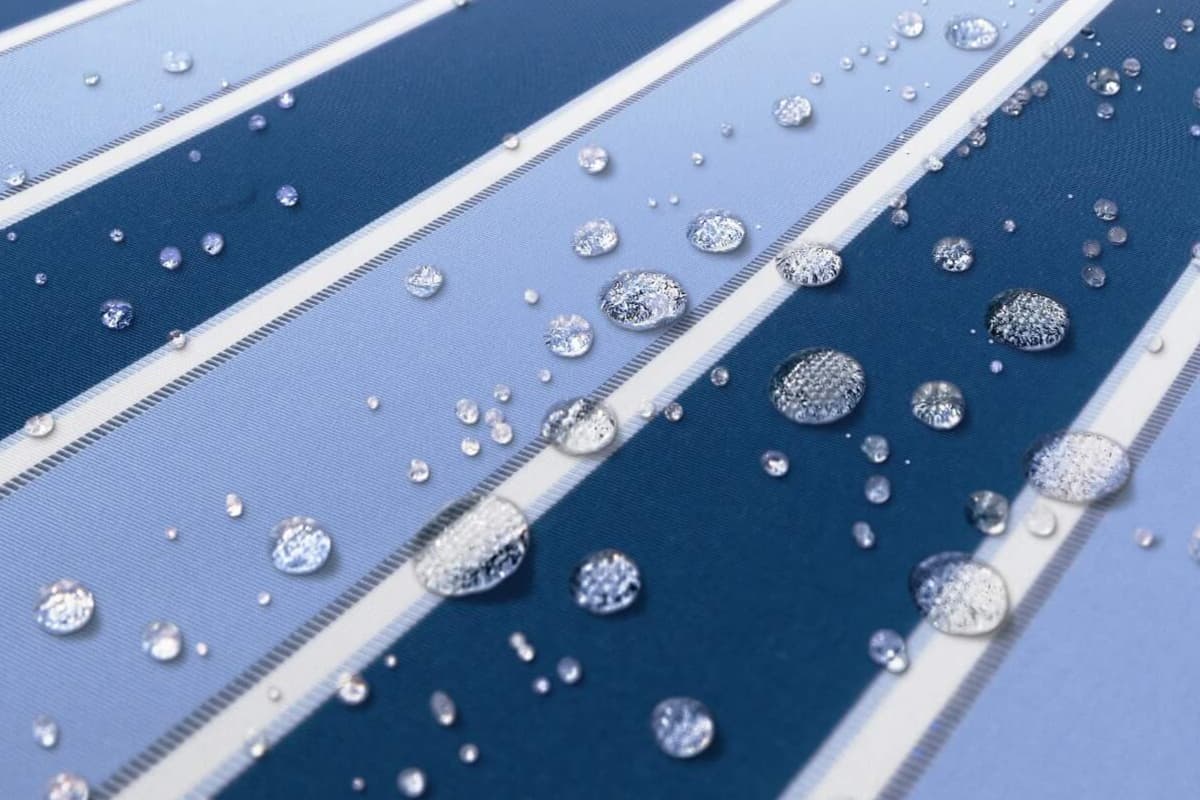
Cleaning your deck umbrella
You should clean your patio umbrella often. This helps it look good and stay free from dirt that can affect its use. Open the canopy completely and, using a hose, spray everything down with water. For detailed cleaning tips, check our article “How to clean a patio umbrella.” Here are some general tips.
Fabric cleaning
Mild soap and water usually work well for most umbrella canopy fabrics. However, always check the manufacturer’s instructions for their advice. Use a sponge, dishrag or soft bristle brush to clean any problem areas. Let the cleaning solution soak in for a bit and then rinse since soapy buildup can lead to mildew. Keep the canopy open to allow the fabric to air dry completely. This is especially important if you’re storing your umbrella.
What to use & what to avoid
Keeping your umbrella canopy clean requires a gentle approach. Avoid using bleach on polyester fabrics, as it can cause fading and degradation. Likewise, harsh detergents can strip protective coatings or damage solution-dyed fabrics like Sunbrella. For umbrellas with removable canopies, you might be able to machine wash them. Always check the care label first to make sure it is safe.
While power washing might seem like a convenient shortcut, high-pressure washers should never be used on umbrella fabric. They can destroy stitching, break down water-resistant coatings, and even tear the canopy itself. Instead, use a mild soap and soft brush or sponge, followed by a thorough rinse. Any leftover soap residue can lead to mildew growth or attract dirt, so take your time with this step.
Let the umbrella dry fully open in the sun until it’s completely dry—especially in humid conditions. Never close or fold it while damp, even partially, as this can trap moisture and cause mildew.

Tackling Stubborn Stains
While regular cleaning with mild soap works for everyday grime, some stains require targeted treatment. For mold or mildew on fabrics, a diluted bleach solution or a special mold remover can work. Just make sure it is safe for your canopy material. Oil and grease stains can often be treated first with a degreaser. You can also sprinkle cornstarch to soak up the residue before washing. For bird droppings and tree sap, prompt removal is key. If you leave these in the sun, they can result in permanent stains. Clean them right away with a damp cloth and a gentle cleaner.
A helpful reference for removing fabric stains
Sunbrella is the “Gold Standard” in outdoor fabrics. They have videos that show how to remove different spills and stains from their solution-dyed acrylic textiles.
Frame cleaning
The directions for washing your umbrella frame are the same, whether it is wood, metal or fiberglass. Using a clean damp cloth, wipe down the ribs, hubs, pole and finial. Be careful around the joints and lift mechanisms. You don’t want threads or debris to get stuck in the moving parts. In most cases, mild soapy water is fine for cleaning dirty areas. However, check the manufacturer’s instructions to be sure. You must avoid using an abrasive cloth or harsh cleaners, as they could damage the finish of your wood or metal frame.
It’s also the perfect time to inspect the moving part of your frame and canopy assembly for damage. If you discover that something is cracked, loose or not working properly, contact the manufacturer. Most high-end outdoor shade brands sell umbrella parts as separate components. Keep the canopy open to allow the frame to completely air dry before closing.
Caring for the frame – Metal & wood
The frame of your umbrella needs attention beyond simple cleaning, too. For wooden umbrellas, like teak or eucalyptus, regular oiling or refinishing keeps their natural color. It also stops cracking or splitting from the weather. Light sanding and reapplication of protective oils can keep the wood looking rich and polished. However, teak is extremely durable even without oiling. It will fade to a silvery grey color over time but the patina does not weaken the hardwood.
For both wood and metal frames, resist the temptation to use a pressure washer. Like with the canopy, too much force can strip finishes or cause structural damage. Instead, wipe down the frame with a damp cloth and mild soap, then dry it thoroughly to prevent corrosion or mildew.
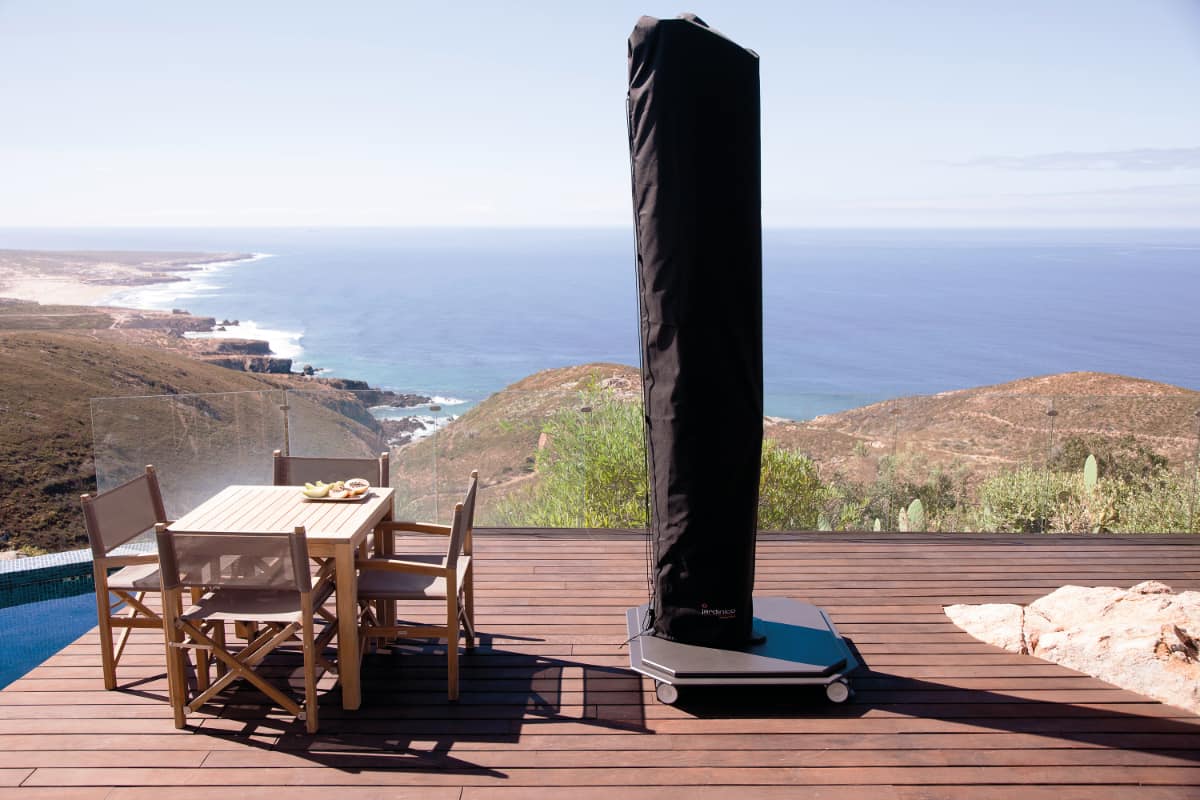
General patio umbrella storage ideas
When the weather is warm and sunny, nobody is thinking about protecting a patio umbrella in winter months. During the off-season or when you don’t use your shade for a while, remove the pole and canopy. Store them safely away from the umbrella base or mount. Properly storing patio umbrellas is relatively easy and effective if you follow a few simple rules.
Inspect before you store
Before packing away your string patio umbrella for the season, take time for a careful inspection. Minor issues—such as small fabric tears, loose screws, or worn hardware—can worsen during months of storage if left unaddressed. By finding and fixing these problems early, you will make your umbrella last longer. This will help you avoid surprises next season.
Choose the right storage environment
When it comes to storing your umbrella, a dry, enclosed area is essential—but that means more than just being out of the rain. Look for a space with stable temperature and humidity levels to prevent damage from extreme heat, cold, or moisture. Avoid locations like attics or uninsulated sheds where temperature swings can accelerate fabric degradation or encourage mold. Protect against pests by sealing fabrics in breathable covers or storage bags to deter mice and insects from nesting in the folds.
Winterize for year-round use
In regions with mild winters where umbrellas might remain outdoors year-round, proper winterizing is key. Always make sure the canopy is completely dry before covering it for a long time. Trapped moisture can cause mold and mildew. Use a weatherproof cover. If you can, elevate the umbrella base a little to stop water from pooling around it. Even when not in use, these simple steps will help your umbrella endure the off-season in good condition.
Storage specifics
- Make sure it’s clean and dry – Follow the guidelines listed earlier, before storing your patio umbrella.
- Use a protective cover – It will prevent moisture build-up, block dust and debris. It will also minimize inadvertent damage from other items brushing up against it.
- Wrap the folds in one direction – To reduce wrinkles and keep your canopy looking good, wrap the folds the same way. Then, secure it in the umbrella cover.
- Cover the pole ends – To minimize damage to the ends of the pole, you should enclose them in cardboard or heavy rags.
- Store it upright – Laying umbrellas on their sides adds extra weight to the ribs. This is especially true if other items are stacked on them or if they might be stepped on.
- Store it in a dry place – Make sure to keep your umbrella in a dry, covered area. Good options are a garage, basement, or pool house during the off-season. Even with a protective cover, cold and moisture can still get in. They can damage items left outside for too long.
Extend the life of your deck umbrella
You invested in a premium outdoor shade, so treat it properly to ensure it works and looks great for as long as possible. If you follow the manufacturer’s manual and regularly check and clean your umbrella, it can last for years.



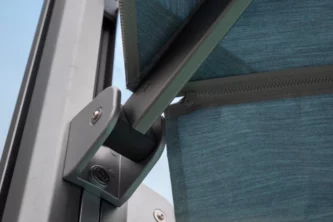
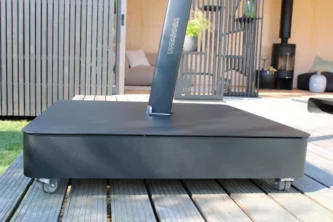
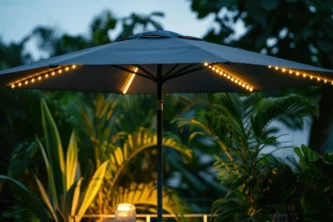





Leave a Reply